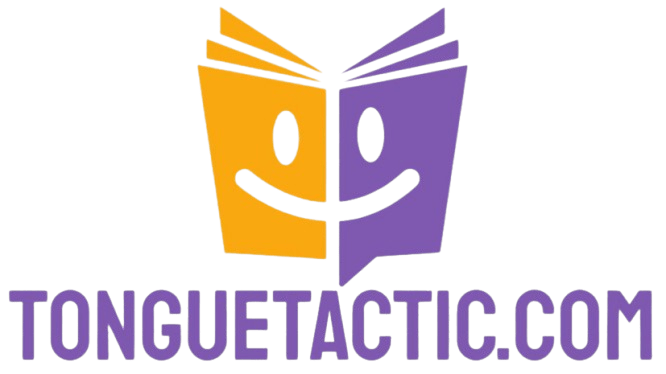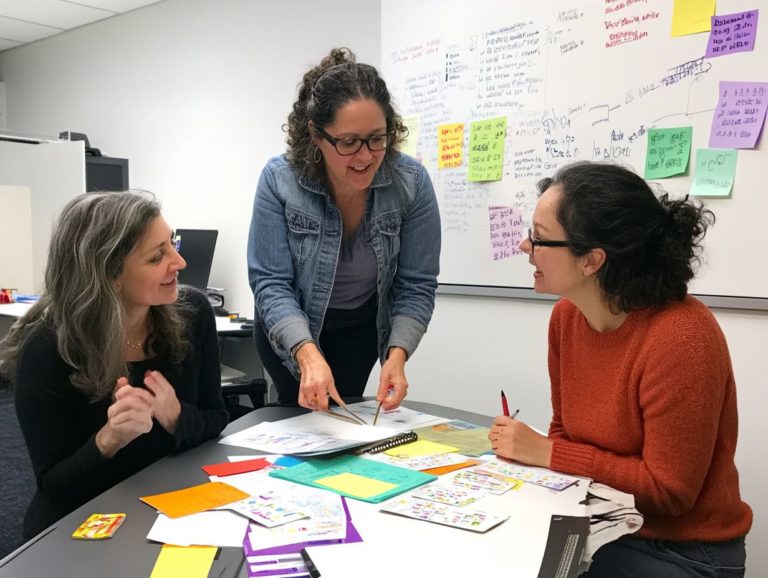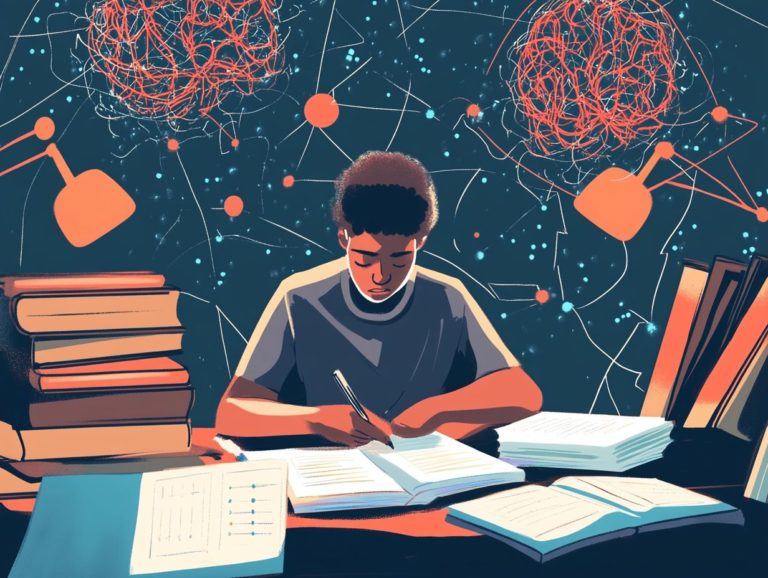5 techniques for enhancing reading skills
Reading skills are the key to unlocking endless opportunities in life! Reading is an essential skill that can unlock a world of knowledge, creativity, and critical thinking for you.
Whether you re diving into dense textbooks, engaging articles, or captivating novels, honing your reading skills can truly transform your experience. In this article, you ll explore five effective techniques: skim and scan, use context clues, make predictions, take notes, and practice active reading. These methods can significantly enhance your comprehension and retention.
You ll discover how to apply these techniques to a range of reading materials, the benefits of sharpening your skills, and the common pitfalls you should avoid. You will also find insights on measuring your progress and strategies to foster growth in various learning environments. Start practicing these techniques today to transform your reading skills!
Contents
- Key Takeaways:
- 1. Skim and Scan
- 2. Use Context Clues
- 3. Make Predictions
- 4. Take Notes
- 5. Practice Active Reading
- What Are the Benefits of Improving Reading Skills?
- How Can These Techniques Help in Different Types of Reading Materials?
- What Are Some Common Mistakes That Can Hinder Reading Comprehension?
- How Can One Measure Their Reading Skills and Progress?
- What Are Some Additional Strategies for Enhancing Reading Skills?
- How Can These Techniques Be Applied in Different Learning Environments?
- Frequently Asked Questions
Key Takeaways:

- Skim and scan to quickly gather information and save time when reading.
- Use context clues to understand unfamiliar words and improve overall comprehension.
- Make predictions to actively engage with the text and enhance critical thinking skills.
- Take notes to summarize and retain important information while reading.
- Practice active reading to increase focus, understanding, and retention of the material.
1. Skim and Scan
Skimming and scanning are valuable reading strategies that help you develop your comprehension skills effectively, especially in a classroom filled with diverse reading materials.
By learning to skim for main ideas and scan for specific information, you can enhance your reading fluency and broaden your vocabulary. This approach deepens your understanding of the text and boosts your confidence, encouraging you to explore a wider variety of reading resources.
Paying attention to headings, subheadings, and highlighted keywords can significantly enhance these strategies. For instance, when you come across a science textbook, skimming through the section titles provides a framework of key concepts. Scanning for bolded terms allows you to locate relevant definitions quickly.
These techniques help you develop deeper literacy skills by promoting critical thinking and selective reading. They enable you to identify essential information without getting bogged down by unnecessary details. Over time, incorporating skimming and scanning into your regular practice sharpens your comprehension and prepares you for real-world reading demands, such as extracting information from news articles or reports.
2. Use Context Clues
Using context clues is a crucial reading strategy that enables you to infer the meanings of unfamiliar words, ultimately enhancing your vocabulary and comprehension skills.
Identifying context clues means recognizing synonyms, antonyms, or specific examples that offer hints about a word’s meaning. For example, when you encounter the word “arduous,” you might see a phrase like “the hike was challenging and required much effort.” Here, “challenging” helps clarify the meaning of “arduous.”
To make this learning process engaging, educators can introduce activities like scavenger hunts, where you search for sentences with difficult words and pinpoint the context clues. Creating word maps that connect unfamiliar words to their definitions through surrounding text clues can deepen your understanding and make the process interactive.
3. Make Predictions
Making predictions before and during reading is a powerful strategy that engages you as a learner and encourages a meaningful connection between your experiences and the narrative, enhancing your comprehension skills.
By anticipating the content of the text, you become more invested in the storyline while activating your prior knowledge, which lays a foundation for deeper understanding. This pre-reading technique prompts you to consider key elements such as characters, settings, and potential plot developments, making the reading process more interactive.
To support this engagement, educators can pose thought-provoking questions or encourage you to create mini-scenarios based on titles and illustrations. Integrating your personal interests into this process further enriches the experience, allowing you to draw from relevant experiences that illuminate your reading and reinforce comprehension.
4. Take Notes

Taking notes while you read is a powerful strategy that helps organize your thoughts and improve retention. This enhances your overall comprehension skills across various texts.
By utilizing a range of note-taking methods, you can elevate this technique even further. For instance, graphic organizers allow you to visualize connections between concepts, while bullet points help distill information into concise summaries.
These techniques can be particularly effective in highlighting key ideas and themes during your reading sessions. This makes it much easier to revisit important content later.
The notes you generate provide valuable assessment opportunities, offering educators insights into your understanding and engagement with the material. This helps identify areas where you might need further instruction or support.
5. Practice Active Reading
Active reading immerses you in the reading process, elevating your comprehension and literacy skills through interactive questioning and summarization.
Incorporating techniques like annotating making notes directly on the text, like underlining key concepts or jotting down questions in the margins can significantly enhance your understanding and retention.
Engaging in group discussions serves as a powerful avenue to deepen your comprehension. You can articulate your thoughts and gain diverse perspectives.
In the classroom, try activities like role-playing scenes from a text or creating visual mind maps. These approaches effectively reinforce active reading practices!
Such methods not only enrich your engagement but also cultivate a greater sense of ownership over your learning journey.
What Are the Benefits of Improving Reading Skills?
Improving your reading skills brings many benefits. You’ll notice enhanced comprehension, a richer vocabulary, and newfound confidence in engaging with various literary texts.
These skills can lead to better academic performance across all subjects. Moreover, developing strong reading abilities improves fluency, enhancing your capacity to express thoughts coherently.
As you explore diverse texts, you sharpen your critical thinking skills, enabling you to analyze information effectively and construct well-rounded arguments.
With advanced reading skills often comes enhanced writing ability, allowing you to articulate your ideas with clarity and precision. These interconnected benefits are crucial for your overall educational development!
They foster a genuine love for learning that transcends the classroom, setting you up for success in all areas of life.
How Can These Techniques Help in Different Types of Reading Materials?
The application of various reading techniques can significantly elevate your comprehension across a wide array of reading materials. This enables you to navigate everything from narrative texts to informational content with ease!
When diving into fiction, focus on character development and plot progression by summarizing key points or visualizing scenes. On the flip side, non-fiction texts brimming with facts and data might be best understood through annotative methods or by utilizing concept maps to connect ideas seamlessly.
When approaching academic texts, a more analytical strategy can come into play. Educators can introduce critical questioning techniques, fostering deeper engagement with the material and encouraging you to synthesize information while exploring differing viewpoints.
By customizing these strategies, teachers can ensure you are well-equipped to tackle the diverse landscape of reading materials effectively.
What Are Some Common Mistakes That Can Hinder Reading Comprehension?

Common reading mistakes can significantly impede your comprehension skills. These include glossing over challenging sections, neglecting to visualize the content, and failing to make personal connections with the material.
These errors often stem from a lack of engagement or misunderstanding of the text s structure. Rushing through reading can lead to missed nuances and themes that are crucial for deeper understanding.
Educators play a crucial role in your reading journey! They can address these pitfalls by introducing targeted activities. For example, guided reading sessions, where teachers help students navigate texts, can improve comprehension.
Assessments that evaluate not just recall but also comprehension can help you pinpoint specific weaknesses. Through discussions and collaborative exercises, teachers can create a supportive environment where you feel at ease sharing your challenges and exploring effective strategies to enhance your reading skills.
How Can One Measure Their Reading Skills and Progress?
Measuring reading skills and progress is essential for you, whether you re a student or an educator. It enables tailored instruction and effective assessment of comprehension abilities.
By employing a variety of assessment methods, you can gain comprehensive insights into your reading proficiency. Standardized tests serve as a benchmark against national averages, helping you pinpoint areas that might need improvement. Self-assessments help you reflect on your abilities and foster self-awareness and motivation.
Engaging in classroom activities, like group readings and comprehension exercises, makes learning enjoyable. These activities also provide real-time feedback to your teachers. Diverse approaches to assessing reading skills inform your instructional strategies and facilitate targeted support, ensuring you can achieve your full potential in literacy.
What Are Some Additional Strategies for Enhancing Reading Skills?
Along with primary reading strategies, you have a wealth of techniques for improving language writing skills to elevate your students’ literacy and comprehension. These strategies ignite their engagement and enthusiasm for reading.
For instance, integrating visual aids like charts, diagrams, and illustrations can transform complex texts into something more accessible and enjoyable.
Storytelling is another powerful approach. It captivates young minds and allows them to connect personal experiences to the material, deepening their understanding in the process. Audiobooks present yet another avenue, enabling students to listen to and comprehend stories that may surpass their reading level.
By weaving these strategies into your curriculum, you can craft a dynamic learning environment that fosters a genuine love for reading and enhances critical thinking skills.
How Can These Techniques Be Applied in Different Learning Environments?
The techniques for improving reading skills can be seamlessly applied across various learning environments, including traditional classrooms, online platforms, and home schooling. This approach ensures that every student has access to effective resources.
By customizing these strategies, you can cultivate an engaging atmosphere that caters to your learners’ unique needs. For example, in a traditional classroom, incorporating group discussions and interactive storytelling can significantly enhance comprehension and retention.
In online settings, you might harness multimedia resources like videos and interactive quizzes to infuse dynamism into the learning experience.
Meanwhile, in the home-schooling context, using everyday reading materials such as cooking recipes or children’s books can seamlessly integrate literacy skills into a broader life context, highlighting the relevance of reading in daily tasks.
Ultimately, the goal should be to create vibrant and participatory learning experiences that resonate with students, regardless of where their education takes place.
Frequently Asked Questions

What are the 5 techniques for enhancing reading skills?
The 5 techniques for enhancing reading skills are:
- Skimming
- Scanning
- Close reading
- Reading for context
- Reading actively
How does skimming help with reading skills?
Skimming is a technique where you quickly read through a text to get a general overview. It helps improve your ability to spot main ideas and important information.
What is the difference between skimming and scanning?
Skimming means reading quickly for a general understanding. Scanning, however, focuses on finding specific information by looking for keywords or phrases.
How can close reading improve my reading skills?
Close reading involves taking your time with a text. You pay attention to details and meanings, which boosts your understanding and thinking skills.
Why is it important to read for context?
Reading for context helps you understand words based on their surrounding text. This leads to a clearer grasp of the overall meaning.
How can I actively read to enhance my reading skills?
Active reading means engaging with the text. You ask questions, make predictions, and connect ideas to deepen your understanding and help retain information.






